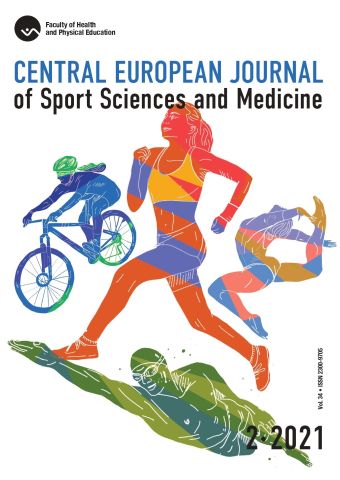
ISSN: 2300-9705
eISSN: 2353-2807
OAI
DOI: 10.18276/cej.2021.2-04




Lista wydań /
Vol. 34, No. 2/2021
Assessment of Young Swimmers’ Technique with Tec Pa Tool
| Autorzy: |
Konstantinos
Papadimitriou
Laboratory of Biological Evaluation of Human Performance, School of Physical Education and Sport Science, Aristotle University of Thessaloniki, Thessaloniki Greece Nikos Papadimitriou Undergraduate student, International Hellenic University , Thessaloniki, Greece Vassilios Gourgoulis 
School of Physical Education and Sports Science, Dimocritus University of Thrace, Komotini, Greece Vassilis Barkoukis Laboratory of Human studies and Sport Psychology, School of Physical Education and Sport Science, Aristotle University of Thessaloniki, Thessaloniki Greece Dimitris Loupos 
Laboratory of Biological Evaluation of Human Performance, School of Physical Education and Sport Science, Aristotle University of Thessaloniki, Thessaloniki Greece |
| Słowa kluczowe: | Butterfly backstroke breaststroke freestyle |
| Data publikacji całości: | 2021 |
| Liczba stron: | 13 (39-51) |
Abstrakt
Aim of the current study was to examine the reliability and validity of a new tool, developed for the assessment of young swimmers’ technique in all swimming strokes. The sample of the study was 119 swimmers (63 boys and 56 girls), aged 8 to 12 years old. To evaluate swimmers’ technique, each of them performed 15m for each one of the swimming strokes in individual medley order. Α digital camera, placed 5m above the pool’s surface, recorded the swimming bouts. Three experienced swimming coaches evaluated the recorded videos with the new technique’s evaluation tool named Tec Pa. Tec Pa assess six important key points of swimming technique in each stroke. According to the results no statistical significant differences were showed between the scores of the swimmers’ evaluation by the three coaches (p > 0.05). Moreover, the association between the scores was statistically significant high (τ = 0.863; p < 0.05). The findings of the current study reveal that Tec Pa is valid and reliable for the young swimmers’ technique evaluation, with high strength of association. Also, Tec Pa can be used by the coaches to enhance the free observation method, which is mainly used, in young swimmers.
Pobierz plik
Plik artykułu
Bibliografia
| 1. | Arellano, R., Lopez-Contreras, G. Sanchez-Molina J.A. (2003). Qualitative evaluation of technique in international Spanish junior and pre-junior swimmers: An analysis of error frequencies. J.C. Chatard (Ed.), Biomechanics and medicine in swimming IX, 87–92. |
| 2. | Andersen, J.T. Sanders, R.H. (2011). A systematic review of propulsion from the flutter kick - What can we learn from the dolphin kick? Journal Sports Science, 12, 1–8. https://doi.org/10.1080/02640414.2018.1436189. |
| 3. | Bartlett, R. (2007). Introduction to Sports Biomechanics: Analyzing Human Movement Patterns. 2nd edition. Routledge Taylor & Francis Group, USA. |
| 4. | Ceseracciu, E., Sawacha, Ζ., Fantozzi, S., Cortesi, M., Gatta, G., Corazza, S., Cobelli, C. (2011). Markerless analysis of front crawl swimming. Journal of Biomechanics, 44, 2236–2242. https://doi.org/10.1016/j.jbiomech.2011.06.003. |
| 5. | Costill, D.L., Lee, G., D’Acquisto, L. (1987). Video – Computer Analysis of Swimming Technique. Journal Swimming research, 3 (2), 5–9. https://doi.org/10.2478/v10078-012-0040-6. |
| 6. | Knudson, D., Morrison, C. (1997). Qualitative analysis of human movement. Human Kinetics. Champaign, IL. |
| 7. | Lätt, E., Jürimäe, J., Mäestu, J., Purge, P., Rämson, R., Haljaste, K., Keskinen, K.L., Rodriguez F.A., Jürimäe, T. (2010). Physiological, biomechanical and anthropometrical predictors of sprint swimming performance in adolescent swimmers. Journal of Sports Science and Medicine, 9, 398–404. |
| 8. | Less, A. (2002). Technique analysis in sports: a critical review. Journal of Sports Sciences, 20, 813–828. https://doi.org/10.1080/026404102320675657. |
| 9. | Ludmina, S., Janine, M.R.D. (2009). A Systematic Review on the Effectiveness of Mental Practice with Motor Imagery in the Neurologic Rehabilitation of Stroke Patients. The Internet Journal of Allied Health Sciences and Practice, 7 (2). |
| 10. | Madureira, F., Bastos, F.H., Corrêa, U.C., Rogel, T., Freudenheim, A.M. (2012). Assessment of beginners' front-crawl stroke efficiency. Percept Mot Skills, 115 (1), 300–8. https://doi.org/10.2466/06.05.25.PMS.115.4.300-308. |
| 11. | Maglischo, E.W. (2003). Swimming faster. Mountain View, California: Mayfield Publishing Company. |
| 12. | Mooney, R., Corley, G., Godfrey, A., Osborough, C., Newell, J., Quinlan, L.R., Ó Laighin, G. (2015). Analysis of swimming performance: perceptions and practices of US-based swimming coaches. Journal of Sports Sciences, 34 (11), 997–1005. https://doi.org/10.1080/02640414.2015.1085074. |
| 13. | Morouço, P., Sacadura, J., Amaro, N., Matos, R. (2010). Evaluation of Age Group Swimmers: A in Field Proposal. The Open Sports Sciences Journal, 3, 38–40. |
| 14. | Ouzouni, H., Nakakis K. (2011). Tool’s reliability and validity in quantitative evaluation. Nursing, 50 (2), 231–239. |
| 15. | Pion, J., Devos, P., Dufour, W. (1988). A rating scale for the evaluation of the breaststroke technique in pedagogical situations. In: Ungerechts B, Wilke K, Reischle K (eds.). Swimming Science V. Human Kinetics, Champaign, IL, 369–373. |
| 16. | Silva, A.J., Costa, A.M., Oliveira, P.M., Reis, V.M., Saavedra, J., Perl, J., Perl, J., Rouboa A., Marinho, D. A. (2007). The use of neural network technology to model swimming performance. Journal of Sports Science and Medicine, 6 (1), 117–125. |
| 17. | Staniak, Z., Buśko, K., Górski, G., Pastuszak, A. (2016). Accelerometer profile of motion of the pelvic girdle in breaststroke swimming. Journal of Human Kinetics, 52, 147–156. https://doi.org/10.1515/hukin-2016-0002. |
| 18. | Strzała, Μ., Krężałek, P., Kaca, M., Głąb, G., Ostrowski, A., Stanula, A., Tyka, A. (2012). Swimming Speed of The Breaststroke Kick. Journal of Human Kinetics, 35, 133–139. https://doi.org/10.2478/v10078-012-0087-4. |
| 19. | Strzala, M., Krezalek, P., Głab, G., Kaca, M., Ostrowski, A., Stanula, A. Tyka, A.K. (2013). Intra-Cyclic Phases of Arm-Leg Movement and Index of Coordination in Relation to Sprint Breaststroke Swimming in Young Swimmers. Journal of Sports Science and Medicine, 12, 690–697. |
| 20. | Suito, H., Nunome, H., Ikegami, Y. (2017). A quantitative evaluation of the high elbow technique in front crawl. Journal of Sports Sciences, 35 (13),1–6. https://doi.org/10.1080/02640414.2016.1221517. |